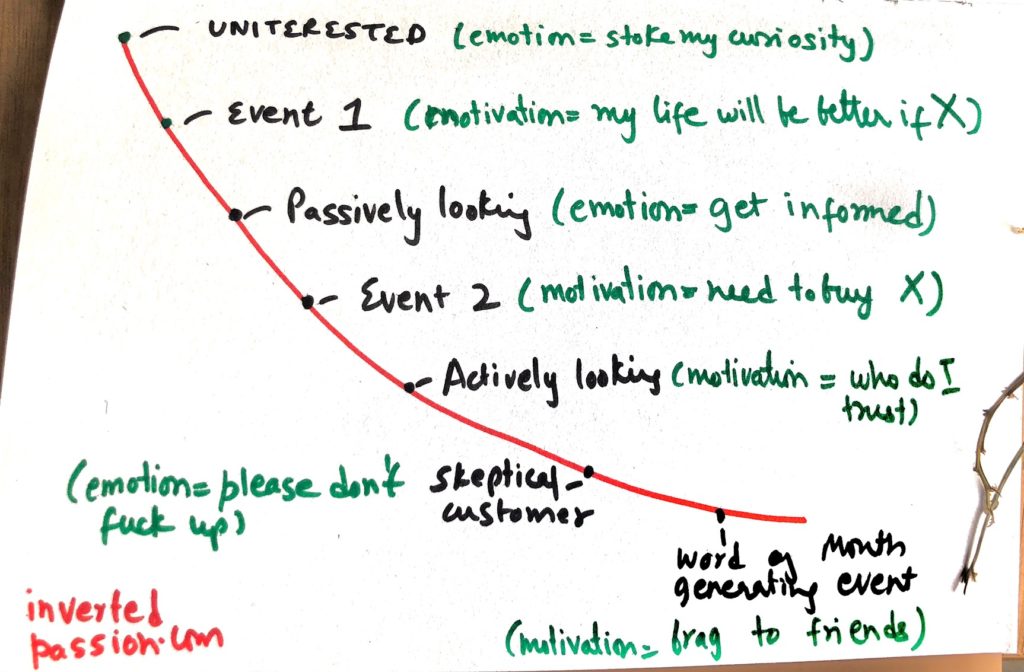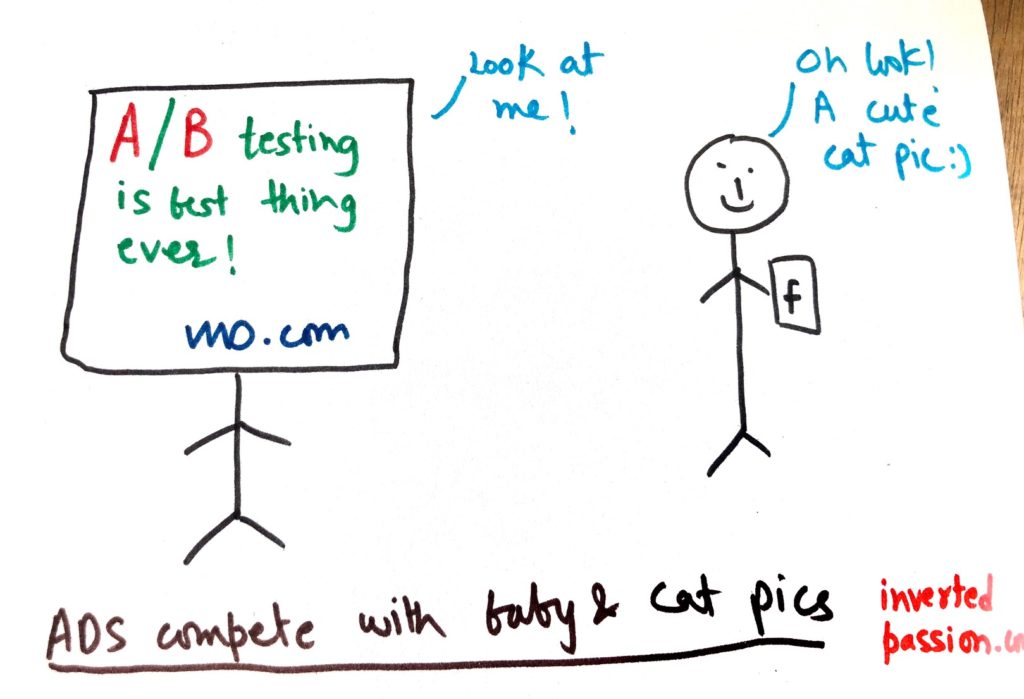Our collective understanding of marketing has a massive hangover from the pre-Internet days. If you ask most people to define marketing, they’d go with definitions like “to inform about the product”, “to create brand awareness” or “to spread the word”. All these definitions are wrong because of the same reason: they serve company’s goals, not customers’.
This error of thinking in which the entrepreneur assumes customers have same motivations as s/he has is called the mind projection fallacy. This error is very common and hard to cure. I’ve written about how it affects entrepreneurs when they design products, get excited about new technology or seek new startup ideas.
In this post, I’ll talk the same error from the marketing standpoint and provide a framework to help design marketing campaigns that don’t fail miserably. (Whether they’re effective or not depends on creativity. Frameworks are inert. Their application is everything)
Nobody cares about your company / product / marketing campaign
If I were to compress my startup advice into one paragraph, it go something like this:
People are busy with their lives. They don’t care that you’re passionate about X. They’ll start caring if your passion makes them passionate about their goals (which usually happens through a deep understanding of their goals, tribes they belong to and emotions they relate to)
There’s essentially not much difference between effective marketing and effective products: both convince the customer to invest in you (attention in the former case, money/time in the latter case). Great marketing campaigns and products go even further: they convince people to market to their friends on your behalf.
How do some marketing campaigns manage to get spread while word of mouth while others struggle to even get noticed? To answer that, first, answer another question.
How many ads do you remember seeing yesterday?
Seriously, close your eyes for 30 seconds and recall all the ads (online or offline) you saw yesterday. Did that? Promise?
Good.
Even though you likely saw 100s of ads (on TV, billboards, online, logos), if you’re like most people, you wouldn’t be able to recall more than a few. (I’m able to recall exactly zero ads from yesterday, and yes, I closed my eyes too).
The reason for this inability to recall ads is because: a) consumers are bombarded with ads; b) marketers are not willing to accept this reality. Most marketers underestimate the extent of competition for consumers’ attention.
We’re hungover from pre-Internet days because we assume that when the ad is seen by the consumer, it registers in her mind. That might have been true in days when people would sit and watch Seinfeld together or in early web era when banners had a 44% click rate. But, today, it’s different: we are Tweeting, watching Netflix and answering emails, all at the same time.
The world is different now. Marketers need to understand that their main competition is not other ads, but Twitter, Facebook, Netflix and Youtube.
The MER framework: what motivations do your consumers have? What emotions will they relate to? how much do you need to repeat?
The Motivation Part
The first step to being a good marketer it to realize that in your target market, only a few are actively searching for your product and consumers at different stages have different motivations / goals. Most of the consumers in target market are either uninterested at the time they see the ad or only passively looking. The same ad cannot talk to consumers at different stages of purchase journey.
Here’s what I think consumers want at different stages:
- Uninterested consumers are motivated to get dopamine rush by coming across something interesting that stokes their curiosity or makes them laugh or shocks/offends them. This is why ads that make people laugh stick in the memory for longer
- An event happens (car breaks down, website conversions go down, friend impresses others with a new smartphone) and consumers start passively looking for ways to make their life better in specific areas (that they identify)
- Passively interested consumers are motivated to look for specific information about products and services. They ask themselves: what aspects do they most care about? Cost, fuel savings, page speed, the speed of integration, screen size, etc. This is a stage where companies need to shape opinions (and not sell, because they’re not actively looking)
- Another event happens (car doesn’t start again, website conversions go down again, another friend buys a new phone) and the consumer resolves to make a purchase. The motivation is to get the best value for themselves.
- Now these actively interested consumers know what they want and are looking for trust-building messages/interactions with a company to finally take the leap and make a purchase. These trust building messages range from social proof to awards to how salespeople treat them in showrooms to online reviews and money back guarantees
- After making a purchase, they’re still skeptical customers and initial interactions with product/service is a deciding factor towards whether they would potentially stick around as long-term customers. People form their trust/mistrust very early on, so their experience of first few seconds, hours and days with your product is important
- Even when they stick around as customers, they’ll not do word of mouth unless: a) you make it really easy to do so (remove frictions); b) doing that makes them look smarter (deliver value to them). Customers don’t go out and tell people about products they use, they do that only for products that make them look/sound successful (brag) around their friends

When it comes to motivations, one big challenge for marketers is that for the same product, different consumers usually have different motivations (jobs to be done). Some like iPhone for design, others buy it because it signals their wealth. These two consumer motivations require very different marketing message (or one super-smart campaign).
If you’ve been wondering how to know your customer motivations in the first place, the answer is easy: get out of the door and talk to them.
The Emotion Part
The second step to being a good marketer is to admit that consumers are busily happy with their lives and your marketing messages compete for the same emotions that they can get from elsewhere. Moreover, at different stages, they seek different emotions. If they’re actively looking and you make them laugh instead of giving them certainty, you’ll fail. Similarly, if they’re looking for a chuckle and you give them certainties, you’ll fail.
Nobody likes using new technology and if they know they want something, they’ll come searching for you. There’s no dearth of good search engines on the web. The challenge of crafting good marketing campaigns is to identify and serve them the right emotion at the right time and do it much better than anyone else.

It also helps to understand that most marketing messages serve not to attract potential customers towards your products but to ensure your competitors don’t snatch them away with their ads. In this sense, the function of most advertising is to prevent sale loss (and not sales).
The Repetition Part
The third step to being a good marketer is that memories fade, life gets in and consumers need to be reminded again and again how the goals they’re motivated to pursue and emotions they seek will be delivered to them by you.

Since most of the target customers are NOT in passive or active looking mode, most of your advertisement will not give any immediate sales. But you want to ensure that you have a high recall when an event in your customer’s life triggers them into first passive and then active looking mode. Because advertisers want to remain on top of the mind, you see car ads on TV even when an average consumer purchases a car once in every four years or so.
Investing in making systems and campaigns for repetition and follow-ups is difficult because marketers live and breathe in their campaigns. Marketers’ marketing campaigns are always top of their mind and they look at them the entire day while the customer looks at it once and then moves on with his/her life. The challenge of the marketer then is to really live the consumer’s life. (And that’s much much harder than it sounds).
To keep the memory refreshed, you need to pursue the consumers on all channels they hang out on.
For B2B, this means your target customers need to see you on TechCrunch, read your blog posts, watch your ads on Youtube, come across your job openings on LinkedIn, and get cold emails from your outbound sales team. Only then you’re likely to be in the shortlist when they get into the passive or active mode (forget about convincing uninterested customers, they have life to live).
For B2C, if your target customer sees your ads on TV, newspaper, billboards, s/he will remember it when the need arises.
The multitude of marketing channels required to create awareness and recall is why marketing easily takes up >50% of expenses for a growing startup.
Summing up the MER (motivation, emotion, repetition) framework for marketing
To sum up this post, here are some of the mistakes from my experience of doing marketing for Wingify (B2B / SaaS).
What went well:
- For the uninterested customer segment, case studies grabbed attention and we published about one per week in early days (like this one: Do human photos on a landing page increase sales and conversions?)
- For the passively interested segment, high search ranking (top 5 results) on Google (for a/b testing tool, a/b testing heatmaps, and many such keywords)
- For actively interested segment, social proof such as 5000+ customers, trust building inside sales process (a human talked to them), and good ratings on third party review site
What didn’t go so well:
- We exhibited at only a few conferences and measured ROI for conferences from leads/business generated (and not from a brand building perspective). We didn’t realize that only a few customers would be in passive or active purchase mode at conferences and to create recall, we had to be seen at multiple conferences.
- We didn’t scale our Adwords spend. Google Adwords is a goldmine for exposing your product to passively and actively interested customers. We had this realization late.
- We created feature-laden, informative ads for display ads on Internet or banners at conferences. We thought since we’re in B2B, we don’t need to make our marketing messages relate to people at an emotional level. We made our top of the funnel ads (directed towards uninterested segment) very informational (read: boring).
- We underinvested in getting press. A more visible brand makes everything else easy. If you have a high recall, consumers will come to you first. Bigger top of the funnel = bigger bottom of the funnel.
That’s all for this post. I hope this framework can help you think clearly what you should be coming up with when anyone asks you about your marketing strategy. It really doesn’t matter if you are running a non-profit, a startup, an enterprise company, a consumer app, a B2B app, a free or paid, service or a side project. If you need to attract people’s attention, you need to be a good marketer.
I’m happy to give feedback on your marketing strategy or particular campaign, just tweet to me or email me (see below on how to do that).
Join 200k followers
Follow @paraschopra